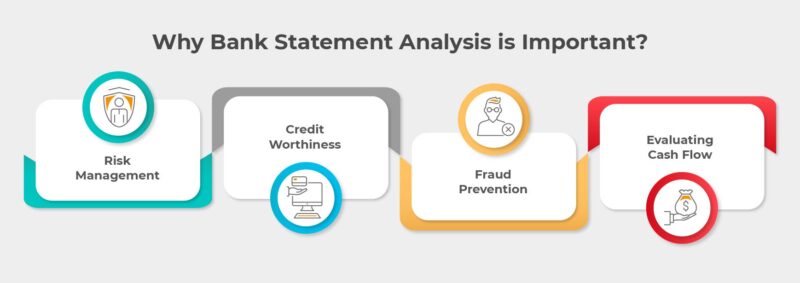Introduction
Being a cornerstone of loan application processing, bank statement analysis is a time-consuming and labor-intensive process. Bank statement analysis is the process of reviewing and analyzing a bank statement to gain insights into a person or organization’s financial situation. The analysis involves reviewing the transactions listed on the statement, including deposits, withdrawals, and transfers, and categorizing them into income and expense categories.
There are a number of reasons for performing bank statement analysis, but most bank statement analysis is performed to evaluate a borrower’s financial health. For example, when a person approaches a banking organization for financial help, the banking organization checks the capability of the borrower’s financial health with respect to income and repayment capacity. After performing a bank statement analysis of the last 6 months of borrowers, banking and financial services make grading or scoring on income and spending analysis to grant loans, that’s what the basic purpose of bank statement analysis is.
Let’s discover more about bank statement analysis in this blog like why it is important and what is the solution to fast-track the bank statement analysis.
Challenges in Manual Bank Statement Analysis
As bank statement analysis include a high number of checkpoints for granting financial help, banking service struggle to manage all manually. As per the record, banking and financial organization received 19.2 million personal loan requests in a year. With such a high number of request banking organizations faces challenges like-
-
-
- Non- Standardized Data Format:
Banking organizations receive bank statement analysis report in various formats such as Excel, PDF, CSV, email, scanned images, and others. Extracting this data, and converting it into the structured format as per the banking requirement makes bank statement analysis more time-consuming. - Human Error:
Manual bank statement analysis is prone to human errors, such as data entry mistakes or incorrect calculations, which can result in inaccurate financial information. - Time-Consuming:
Manual bank statement analysis can be a time-consuming process, especially for large organizations or businesses with a high volume of transactions. It may take days or weeks to complete the analysis, which can delay financial reporting and decision-making which further leads to delays in offering financial help to customers. - Lack of Data Insights:
Manual bank statement analysis may not provide the same level of insights and data visualization. This can limit the ability of organizations to analyze income and spending patterns to give grading or scoring as per the bank statement and give on-time financial help to its customers. - Security Risks:
Manual bank statement analysis can pose security risks, especially if sensitive financial information is being handled by multiple people. This can increase the risk of data breaches, fraud, and other security incidents.
- Non- Standardized Data Format:
-
What is AutomationEdge Ready Workflow for Bank Statment Analysis?
AutomationEdge utilizes a combination of RPA+OCR+Machine Learning approach to reduce the manual intervention involved in performing the bank statement analysis process. Instead of banking employees working on steps involved in AutomationEdge RPA bot can-
- Extract bank statements from multiple sources
- Standardized the data as per banking requirements
- Analyse borrower data to gain insights related to cash flow
Let’s see how bank statement analysis looks with AutomationEdge-ready solution workflow.

Going automation way in the bank statement analysis process, underwriters can generate accurate results on every file. And automation will also help in delivering a fast and frictionless loan review process for borrowers.
Conclusion
Automated bank statement analysis offers a remarkable speed of response, eliminating the need for human labor and ensuring error-free analysis. That’s how automation can be particularly advantageous for banks and financial institutions as it facilitates swift lending decisions, real-time monitoring, and better risk management.
And to help you create end-to-end bank statement analysis AutomationEdge ready-solution workflows can meticulously help you in achieving that. To know more click here
The post Bank Statement Analysis Challenges, Solution, and Benefits appeared first on AutomationEdge.
This is a companion discussion topic for the original entry at https://automationedge.com/blogs/bank-statement-analysis-challenges-solution-and-benefits/
